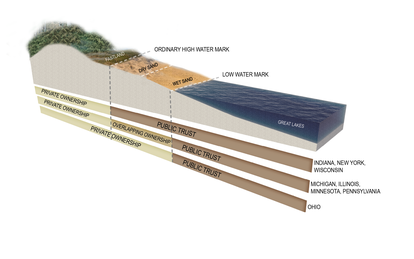A Brief Legal History of Littoral Rights in the Great Lakes

Many Great Lakes cities are now seeing their waterfronts as possible public access points and economic development areas, and less as properties with manufacturing plants of coal-fired electric power stations. But the issue of who has access to waterfront property is very complicated in the Great Lakes, and courts are getting more and more cases to redefine public law that goes back centuries.
Roman law had distinct legal definitions of what rights a landowner had in relation to the water he lived next to, and this was carried into British common law in the 1500s. When the British immigrated to the new world in North America in that time period, they applied their long-adopted water/land legal interpretations to the colonies they established along the Atlantic Ocean coastline.
Those old laws are still on the books. But how this affects the Great Lakes is when the “riparian” laws moved westward. Under old British law, and still active today, legal access to waterfront properties is defined by the tides. Meaning that the public has legal access to the land between the high and low tides of the ocean. But as settlers moved west into the Northwest Territory (the current Great Lakes states) after the Revolutionary War, the tidal part of the law was determined unenforceable because the Great Lakes tides were almost non-existent.
The Midwest property owners have been ruled to have ownership up to the shoreline. So in Rhode Island, the land between ocean’s high and low tides is available for public access. In Michigan on Lake Huron for example, the saying goes, “if you have one foot dry and one foot wet, you are trespassing.”
The courts and state governments are trying to re-set the laws, but it is difficult to do because the riparian laws encompass the Great Lakes, ponds, rivers and streams. Cities and states are still finding that virtually the only way to get property for parks on the lakefront – and the public access that they will bring -- is to have it donated by private owners.
All this may be changing. The Indiana Supreme Court ruled in early 2019 that the public has the right to walk the Great Lakes shoreline, even along privately owned beaches. The dispute was between the state and home development that wanted keep the public away from their properties, including the Lake Michigan waterfront.
Michigan Governor Gretchen Whitmer was pleased with the Indiana court rulings. “This decision is good news for our Great Lakes and for people across the state,” she said in a statement. “We in Michigan are defined by our water. Whether you’re fishing, swimming, or climbing the dunes on Lake Michigan, so many memories are made on the shores of our Great Lakes. [This] decision is an important step in making sure that people across the state and from all over the world can continue to enjoy the Great Lakes.”